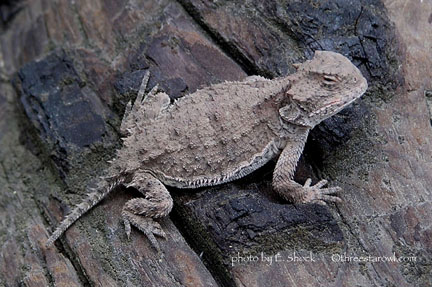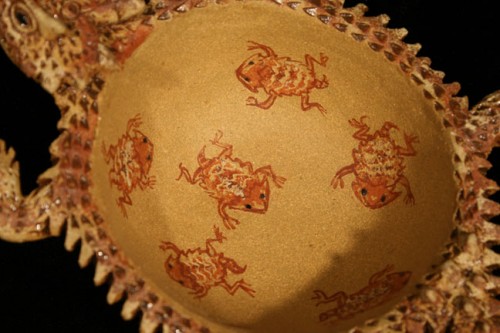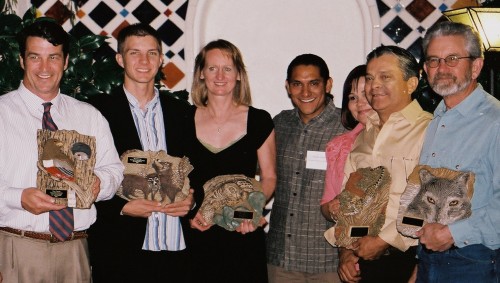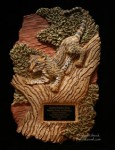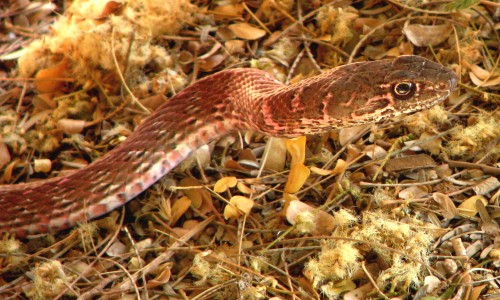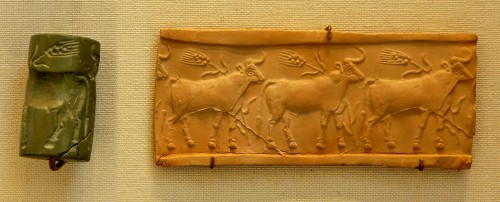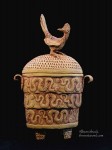Poor Old Papago Park
One of my simple pleasures is going on early morning walks with E around the buttes in Papago Park. We can walk there from our house, and though the walks are for health, we always make note of birds and the other animals we see.
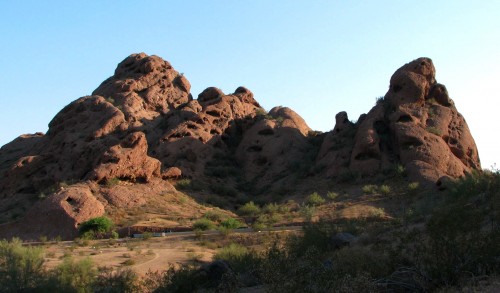
A first impression of this landscape is accurate: a worn scrap of urban desert, surrounded by buildings and golf courses. (At 1200 acres, this scrap seems to be getting smaller all the time, as the City of Phoenix doesn’t seem to be able to keep its hands to itself: even this morning we noticed a shiny chain link fence slashed across the creosote flats, closer to the butte trail than just a few days ago; a golf-course expansion, I suppose, because Phoenix doesn’t have enough acres in fairways?) I don’t have a biologist’s expertise, but the buttes and the land between them don’t seem to be a rich or terribly diverse environment. Next to the lush Zoo and wonderful Desert Botanical Garden, where the birding is always great, the part of Papago west of the parkway seems especially barren. Sometimes we only see a handful of bird species, and no mammals but other humans and their dogs (and only a few of those in our early hours). But over the years and through all seasons in all weather, we’ve discovered that there’s more in Poor Old Papago than you might expect.
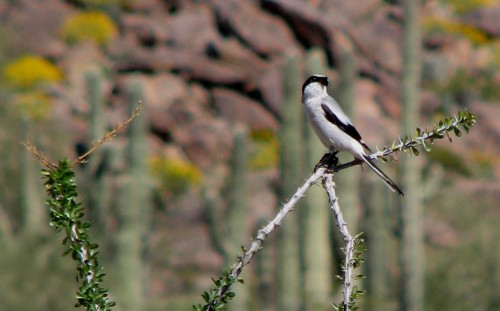 This morning’s walk was a perfect example. In addition to the numerous mourning doves and house finches, there were two Loggerhead shrikes in the park, fierce “functional raptors” looking for a protein-rich breakfast like a grasshopper or small lizard. They were making their ratchety “shrike-shrike” call from the tops of the greened-up creosotes, so we heard them before we saw them, though once we got closer the shrikes’ bold gray, black and white plumage blinked in the sun. The verdins saw the shrikes too, emitting incessant alarm calls and flicking their wings.
This morning’s walk was a perfect example. In addition to the numerous mourning doves and house finches, there were two Loggerhead shrikes in the park, fierce “functional raptors” looking for a protein-rich breakfast like a grasshopper or small lizard. They were making their ratchety “shrike-shrike” call from the tops of the greened-up creosotes, so we heard them before we saw them, though once we got closer the shrikes’ bold gray, black and white plumage blinked in the sun. The verdins saw the shrikes too, emitting incessant alarm calls and flicking their wings.
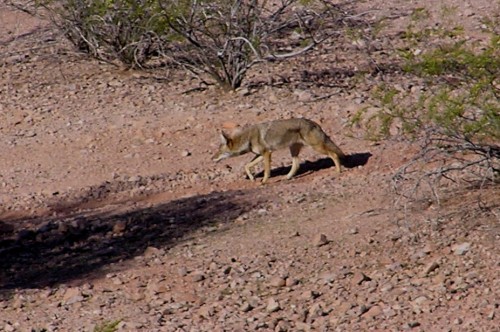 The serious, top-order predators were out, too: a Red-tailed hawk launched itself with a cry off the rock we call “Jaws” and flew south to the biggest butte, Barnes Butte (named after Will C. Barnes who is known himself for writing a book on Arizona place names). And the ‘yotes were out: Coyotes are pretty common in the park. This morning we saw two together, an apparent family: an adult and young one, looking a bit scruffy, like the park itself. We’ve seen coyotes actually stalk dog-walkers, maybe keeping an eye on things until the other four-legs are off their patch of land. When fire engines hurtle by, the Butte “goes off” and invisible ‘yotes howl and yip until the sirens are faint.
The serious, top-order predators were out, too: a Red-tailed hawk launched itself with a cry off the rock we call “Jaws” and flew south to the biggest butte, Barnes Butte (named after Will C. Barnes who is known himself for writing a book on Arizona place names). And the ‘yotes were out: Coyotes are pretty common in the park. This morning we saw two together, an apparent family: an adult and young one, looking a bit scruffy, like the park itself. We’ve seen coyotes actually stalk dog-walkers, maybe keeping an eye on things until the other four-legs are off their patch of land. When fire engines hurtle by, the Butte “goes off” and invisible ‘yotes howl and yip until the sirens are faint.
There’s plenty for the coyotes to eat, actually, if they can catch it. Stray cats, for instance. (When we first started walking in the park, one of our landmarks was “Half-cat Stash” — a bit of feline jerky with clumped, sun-bleached pelt patches that was gradually being reduced by some not very picky predator) Also, there are 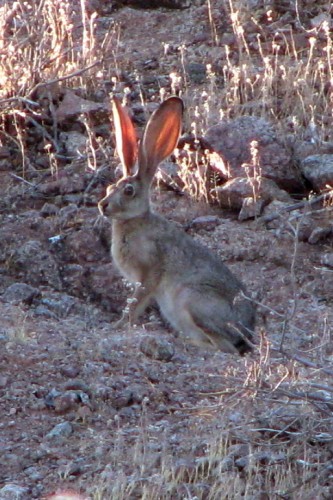 Black-tailed jackrabbits. We’ve seen as many as eleven during one walk, their radiator-ears glowing pink with the low sun shining through them. Desert cotton-tails are common, too. These tough lagomorphs are numerous enough in the park so that the City has had to chicken-wire the young saguaros to keep them from being girdled by gnawing teeth. The cactus situation is at best marginal in the park: there are few new ones coming up, and some of the old saguaros are dying: one we called the “Condo” because it hosted numerous starlings and a Gila woodpecker or two just recently came down in a monsoon windstorm. Now it’s lying there rotting, gradually watering its nurse tree. Hard to believe this land was designated Papago Saguaro National Monument from 1914 until 1930, known for the stately columnar cactus. But now, Papago definitely calls out for some succulent guerilla gardening…
Black-tailed jackrabbits. We’ve seen as many as eleven during one walk, their radiator-ears glowing pink with the low sun shining through them. Desert cotton-tails are common, too. These tough lagomorphs are numerous enough in the park so that the City has had to chicken-wire the young saguaros to keep them from being girdled by gnawing teeth. The cactus situation is at best marginal in the park: there are few new ones coming up, and some of the old saguaros are dying: one we called the “Condo” because it hosted numerous starlings and a Gila woodpecker or two just recently came down in a monsoon windstorm. Now it’s lying there rotting, gradually watering its nurse tree. Hard to believe this land was designated Papago Saguaro National Monument from 1914 until 1930, known for the stately columnar cactus. But now, Papago definitely calls out for some succulent guerilla gardening…
Even after all the walks we’ve taken In Papago Park, E and I are still seeing things for the first time, like the barrel cactus we found this summer only because the monsoon has been better than usual. Normally invisible against the gravelly soil the heads of several barrels blazed out in the washes because rain had soaked them over night and their normally dry, brown spines had taken on their true color: bright red. We know where one hedgehog cactus grows, having seen it only because it was in full bloom. There are even pincushion cactus, Mammillaria grahamii (or “mammo-grahams” as we’ve nicknamed them, Graham’s nipple cactus) tucked away on a sunny slope of the little butte. One day we hope to catch them blooming, too. Even more invisible was a Lesser nighthawk on her nest,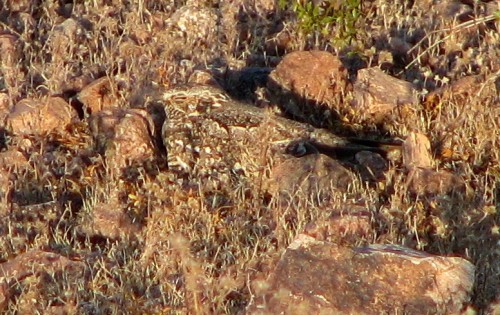 staunchly incubating through the monsoon season, hidden in plain sight under a small creosote. We don’t know for sure if she successfully fledged her young, but we’d like to think so. Can you find her invisibly sitting tight on her nest in the photo above (Spot the Bird)?
staunchly incubating through the monsoon season, hidden in plain sight under a small creosote. We don’t know for sure if she successfully fledged her young, but we’d like to think so. Can you find her invisibly sitting tight on her nest in the photo above (Spot the Bird)?
There are always surprises: last fall a gleaming, swift Prairie falcon lingered in the high rocks and air overhead; we watched it for two weeks before it moved on. Also, what was left of a Barn owl, abandoned on the top of a rock after it had become a meal for a Great horned owl (they’re there although we’ve never seen one — occasionally there’s a softly barred feather caught fluttering in a shrub). There are strangers, too: an exotic male zebra finch hung out with a 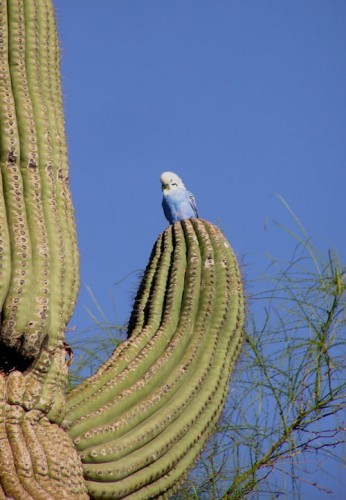 flock of native house finches for a week or so; and nearby there’s a thriving breeding population of Budgies (parakeets) nesting in saguaro cavities.
flock of native house finches for a week or so; and nearby there’s a thriving breeding population of Budgies (parakeets) nesting in saguaro cavities.
Lodged in the cracks between Phoenix, Tempe, and Scottsdale, Papago Park may not seem a terribly wild place, but it is something very precious in the middle of the metropolitan area: open desert space in an area that’s been the residential heart of the Rio Salado settlement for thousands of years.
Poor Old Papago Park. There’s been talk of “improvement” for Papago for years. Does it need improvement? In my view “Improvement” doesn’t always include parking lots, pavement or pathways. Because the beauties and benefits of Papago are subtle and in their natural state, I fear they will be overlooked by ambitious city managers, profit-seeking developers and even well-meaning citizens eager to “improve” something that doesn’t need improvement, but rather a little appreciation for what it is.
All photos©threestarowl.com. All photos in this post taken by E. Shock in Papago Park, except the Loggerhead shrike, taken on the Margie’s Cove trail in the Maricopa Mountains.

